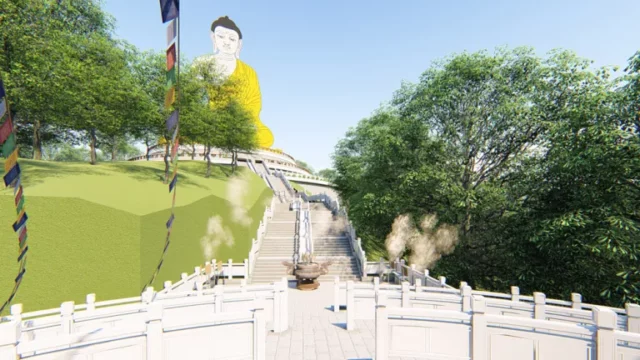DHARAN: When envisioning the world’s tallest Buddha statue, one might picture the serene landscape of Chotimorang Hill on the Koshi Highway, leading from Dharan to Bhedetar.
At the helm of Dharan, Bhedetar is not only a gateway but also a picturesque destination in the east.
A colossal ‘Thousands Big Buddha’ statue, standing at a towering height of 150 feet (46.75 meters), is on the verge of realization near Bhedetar.
The ambitious project has sparked comparisons with the famed Big Buddha in Hong Kong’s Lantau Island.
The first phase of the project has recently seen the unveiling of a detailed report (DPR) for the construction of a Buddhist Study Center, accompanied by the installation of the monumental Big Buddha statue on Chhotimorang Hill.
According to the DPR, if the ‘Thousands Big Buddha’ comes to fruition, it will surpass the height of Hong Kong’s Big Buddha by an impressive 12.75 meters.
The anticipated statue is poised to claim the title of the world’s tallest Big Buddha, surpassing the current record held by the 34-meter-high Big Buddha in Hong Kong, crafted from bronze metal in 1993.
The Council of Ministers, in a meeting on July 31, 2017, granted the rights to utilize the hill of Chhotimorang in Dharan sub-metropolitan city-4 for the Suryodaya Buddha Vihar as a religious forest.
Pradeep Thapa, the visionary behind Big Buddha, played a role in securing the land, prompting the government’s support to make the site available for this monumental venture.
With the land secured, the project’s infrastructure is now in the process of being prepared through collective fundraising efforts.
Thapa, along with his team members, is taking strides to turn the vision into reality.

The project has garnered international support, with key figures like former president of the Hong Kong Nepali Federation Tanka Rana, current federation president Rita Gurung, and others participating.
Notable individuals such as Hong Kong District Councilor Aruna Gurung and social worker Pushpa Gurung have extended their support, highlighting the global interest in the initiative.
Speaking to Khabarhub, Thapa emphasized the potential economic benefits for Nepal, drawing inspiration from Hong Kong’s success in tourism revenue generated through monumental Buddha statues.
Thapa envisioned showcasing Nepal’s Buddha to attract both domestic and international tourists, echoing the prosperity witnessed in Hong Kong.
A Vision Manifests with Concrete Plans
Thapa underscored the transformative impact a monumental Buddha can have, citing Hong Kong’s success and its ability to draw over 20,000 visitors daily.
While acknowledging that replicating Hong Kong’s budget may be challenging, he emphasized the potential to enhance the beauty of our own hills in Nepal.
Despite not receiving the entire budget from the government, Thapa expressed contentment that the construction of the Thousand Big Buddhas in Thumkidanda, Chotimorang, is progressing with the support of donor agencies from both home and abroad.
He highlighted the commitment to financial transparency, assuring that the project is devoid of profit motives or commissions, with contributors willingly investing in the venture for the benefit of future generations.
Discussions are underway with the monastery development committee regarding the construction of the Thousand Big Buddha on Chhotimorang Hill, approximately 14 km from Dharan.
Thapa, currently in Kathmandu, shared ongoing talks with the Gumba Development Committee, aiming to finalize the next phase and fundraising strategies.
He expressed confidence in Dharan’s potential to become a jewel of the sub-metropolitan city, crediting Mayor Harka Sampang’s nature-loving disposition and support for labor donation as factors that will contribute to the project’s success.
The DPR, crafted by Sunlight Developers and Suppliers Pvt., outlines a comprehensive plan aimed at attracting a diverse audience, including domestic and international tourists, Buddhist devotees, meditation enthusiasts, and nature lovers.

With an estimated daily footfall of 7,000 to 10,000 visitors upon completion, the project aims to stimulate local economic development.
Meanwhile, technical work has been underway since the formal allocation of land by the government.
Soil tests and structural analyses have been completed, and the architectural framework is finalized.
The DPR, designed by Civil Engineer Suman Shrestha, Architect Puja Shrestha, and Yuman Shakya, envisions a 150-foot Big Buddha statue mounted above Pema.
A disabled-friendly route from the Koshi Highway to the statue will be established, adorned with stupas and incense burners.
The Buddha structure will encompass a two-story museum hall, a revolving and meditation center, rotating manes along the railings, and a waiting room, providing a holistic experience for visitors.
The dream of the Thousands Big Buddha is taking shape, merging spiritual significance with architectural excellence.
Meanwhile, the upper floor of the Thousand Wig Buddha complex is envisioned as an immersive experience, featuring Buddha’s biography and teachings through intricate paintings.
Historical and archaeological artifacts related to Buddha will find a home here.
In close proximity to the majestic statue, facilities such as a canteen, toilets, waterfalls, and a chronicle of Dharan’s history from antiquity to the present will enrich the visitor’s journey.
Yuman Shrestha revealed that while the project remains the same, the Detailed Project Report (DPR) has been prepared with three options.
The estimated cost for the Big Buddha statue alone is around 14 million rupees, with an additional 10 million rupees required for the two-story structure.
However, Shrestha emphasized that if ancillary structures like a college building and library dedicated to Buddhism are incorporated, the budget may see an increase.
The choice between copper and fiber for the main statue remains undecided.
Shrestha, leaning towards copper for its durability over centuries, cautions against the uncertainty and vulnerability of fiber to weathering.
The physical structure has been engineered to accommodate up to a thousand visitors simultaneously, ensuring a seamless and secure experience.









Comment